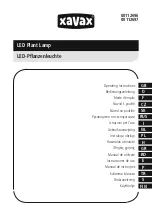
6-
Dip-switches
# 1
# 2
# 3
# 4
# 5
# 6
# 7
# 8
# 9
#10
Value
1
2
4
8
16
32
64
128
256
2-light show
Ѓ Examples:
Channel 1
:
dip / on: #1 (=1)
Channel 4
:
dip / on: #3 (=4)
Channel 7
:
dip / on: #1, #2,#3 (1+2+4=7)
Channel 10
:
dip / on: #2, #4 (2+4=10)
5. DMX 512 Configuration
7-
6. DMX 512 Connection
The DMX 512 is widely used in intelligent lightings and with a maximum of 512 channels.
1. If you using a controller with 5 pins DMX output, you need to use a 5 to 3 pin
adapter-cable.
2. At last unit, the DMX cable has to be terminated with a terminator. Solder a 120
ohm 1/4W resistor between pin 2(DMX-) and pin 3(DMX+) into a 3-pin XLR-plug
and plug it in the DMX-output of the last unit.
3. Connect the unit together in a ‘daisy chain’ by XLR plug from the output of the unit
to the input of the next unit. The cable can not be branched or split to a ‘Y’ cable.
DMX 512 is a very high-speed signal. Inadequate or damaged cables, solder
joints or corroded connectors can easily distort the signal and shut down the
system.
4. The DMX output and input connectors are pass-through to maintain the DMX
circuit, when power is connected to the unit.
5. Each lighting unit needs to have an address set to receive the data sent by the
controller. The address number is between 0-512 (usually 0 & 1 are equal to 1).
6. The end of the DMX 512 system should be terminated to reduce signal errors.
7. 3 pin XLR connectors are more popular than 5 pin XLR.
3 pin XLR: Pin 1: GND, Pin 2: Negative signal (-), Pin 3: Positive signal (+)
5 pin XLR: Pin 1: GND, Pin 2: Negative signal (-), Pin 3: Positive signal (+)























